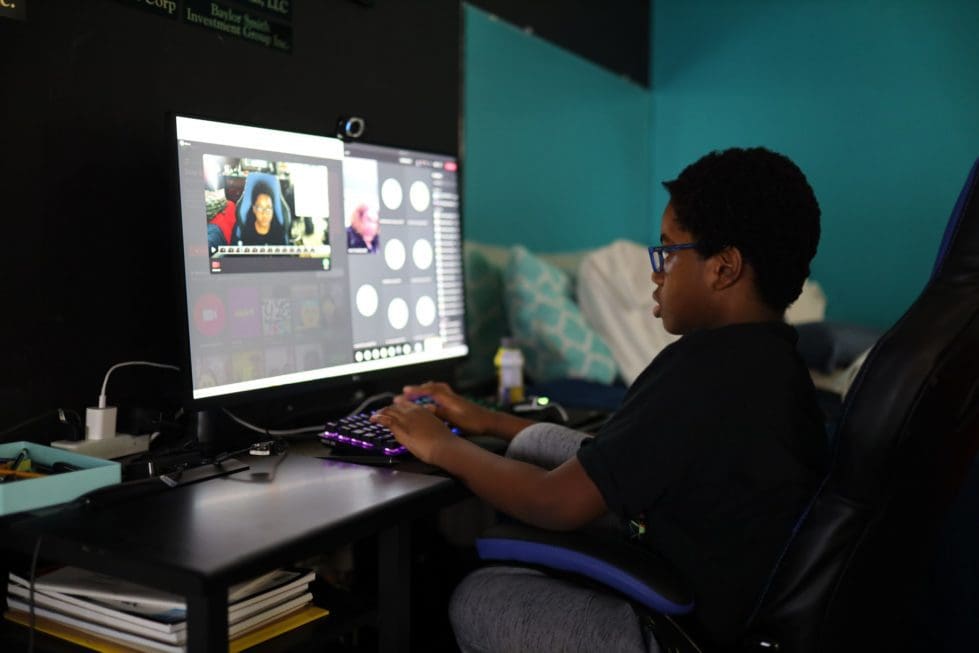
Christina School District is using federal COVID-19 money to hire tutors for two years to help its students catch up. Photo by Ralston Smith/Unsplash
Over 600 students in Christina School District are taking part in a district-wide one-on-one virtual tutoring program to help them climb the ladder of proficiency in math and reading.
The results: About 60% of those who started last summer have moved from below grade level to at least early grade level in both language arts and math.
The program, which doesn’t have a name, pays for four tutorial companies to provide the service. The district is using federal Elementary and Secondary School Emergency Relief funds, some of which are designated to help schools recover from pandemic learning loss.
Joining the tutoring program was voluntary.
“The 600 students exceeds my expectations for the program,” said Gina Moody, director of student services and whole child support at Christina School District. “The high number of students involved in just the first year shows how popular and much-needed it is among Delaware’s youth.”
The program was up against not only pandemic learning loss, but also lingering statistics that show fewer than 50% of Delaware’s students read at grade level. Students struggling with reading are more likely to drop out of school and get in trouble with the law.
The tutoring program divides participants into three categories: Students in the red zone are below grade level. Those in the yellow zone are at early grade level. Students in the green zone are at or above grade level.
Students could opt to start their lessons over the summer or they could begin at the start of the school year, with lessons taking place throughout the current school year. Both groups of students showed significant improvement in their math and English language arts learning.
For those that began lessons last summer, 52% of the students were in the red zone for English and language arts in the fall. By the end of winter, just 39% of the students were in the red, meaning 61% of the students were either early grade level, at grade level, or beyond.
55% of students who began math lessons last summer entered their fall semester in the red zone. At winter’s conclusion, only 36% were in the red zone. 64% were at least at early grade level learning.
Students that started lessons at the beginning of the school year experienced similar results.
61% of these students entered the school year at a sub grade level mark for English language arts. Only 47% of those students were still in the red zone after winter. 53% of students were at least at early grade level.
At the beginning of the year, 69% of this group of students entered the fall below grade level for math. At winter’s end, this number dipped to 43%, with 57% of students reaching proficiency.
Parents are pleased.
Peije Rollins has two children, Dominique and Draya, who are enrolled in the district’s tutoring services. She’s noticed a tremendous difference in both of her children.
“Draya wasn’t really comprehending words that well this year and two weeks of being tutored, she started coming home with As on her spelling tests,” said Rollins.
She said Dominique and Draya look forward to their weekly sessions and love working one-on-one with their tutor.
Christina turned to private tutoring companies for the help.
In Spring 2021, the district asked Back to Basics, Learn It, A Friend of the Family and Results Tutoring to work with its children.
“I’m scratching my head and thinking, ‘What the hell is every other district in the nation doing’,” said Juli Bennett, executive director of Back to Basics, which has 200 tutors working with 450 students at Christina.
Back to Basics frequently sends out surveys to receive parental feedback.
“Parents are noticing their kids are more confident with school,” she said, “and they’ve told me their kid’s self-esteem has gone up and there’s an eagerness to meet with their tutor every week.”
The virtual one-on-ones are a lot different than the disengaging zoom call of 25 or more kids that students became accustomed to during the pandemic.
“Most schools believe that virtual learning doesn’t work,” said Bennett, “but they don’t realize that virtual one-on-one’s are different – they help build a close relationship.”
Christina sends Back to Basics new students every month, she said, and sometimes they come and go just when they need a little extra help, while many stay the entire year.
Moody said the district used $3 million of its $83 million in ESSER funds for the program.
Sen. Colin Bonini, R-Little Creek, said he strongly supports more intensive learning environments like tutoring programs.
“There’s no question that many of our students really suffered during the pandemic,” he said, “and we have to do all we can to try to get them back up to speed.”
Faculty in a student’s school also play a large role in recommending students for the tutoring program, which is free to the students. Their families only have to provide a space for the child to engage virtually with a tutor.
“After parent conferences and at the end of the marking periods, principals and school leaders will reach out and say, ‘Hey, I have a few more kids I think could really benefit from the program’ and I’ll just keep adding them to the program as they come,” said Moody.
Students may stay in the program for the 2021-22 school, but also are allowed to step away. A typical tutoring schedule will be two sessions a week, with a session lasting between 45-minutes and an hour.
Moody said the program started with a specific number of slots for schools, and each school being able to invite students to take part, Moody said.
The tutoring agencies can see the family responses and reach out to arrange sessions.
“Say for whatever reason, timing didn’t work out or someone says they don’t want to participate,” Moody said, “the tutoring agencies continue to reach out to the student and parents throughout the year.”
Students can be tutored in math, English language arts or both.
High school tutoring can be more specialized on a case-by-case basis, as long as tutoring agencies have the capacity to help.
“We have some high school students who wanted tutoring help in AP Geography or U.S. History,” Moody said, “so there are other subject options, but it’s mainly been math and reading.”
During the tutoring session, students often go over materials they have access to via their class instruction, but the tutors often bring agency materials to provide additional resources for the students.
Moody said most students have responded enthusiastically and actively participate, and students who might be hesitant to sign up initially typically come around.
The program isn’t capped and won’t be as long as the district has the financial capabilities to continue it, Moody said.
She expects the program to be extended into Summer 2022 and next school year.

Raised in Doylestown, Pennsylvania, Jarek earned a B.A. in journalism and a B.A. in political science from Temple University in 2021. After running CNN’s Michael Smerconish’s YouTube channel, Jarek became a reporter for the Bucks County Herald before joining Delaware LIVE News.
Jarek can be reached by email at [email protected] or by phone at (215) 450-9982. Follow him on Twitter @jarekrutz
Share this Post




